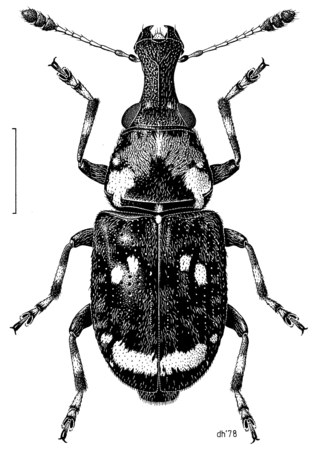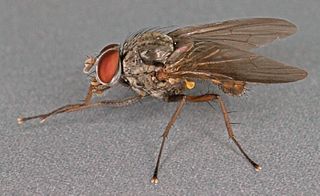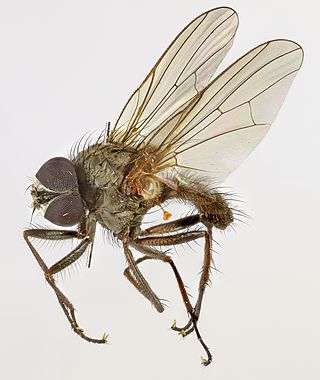
Herring are various species of forage fish, mostly belonging to the family of Clupeidae.

The Anthomyiidae are a large and diverse family of Muscoidea flies. Most look rather like small houseflies. Most species are drab grey to black. Many Pegomya are yellow, and some members of the genera Anthomyia and Eutrichota are patterned in black-and-white or black-and-silvery-grey. Most are difficult to identify, apart from a few groups such as the kelp flies that are conspicuous on beaches.

The genus Calyptra is a group of moths in subfamily Calpinae of the family Erebidae. They are a member of the Calpini tribe, whose precise circumscription is uncertain but which includes a number of other fruit-piercing or eye-frequenting genera currently classified in Calpinae.

A leaf miner is any one of numerous species of insects in which the larval stage lives in, and eats, the leaf tissue of plants. The vast majority of leaf-mining insects are moths (Lepidoptera), sawflies, and flies (Diptera). Some beetles also exhibit this behavior.

Anthribidae is a family of beetles also known as fungus weevils. The antennae are not elbowed, may occasionally be longer than the body and thread-like, and can be the longest of any members of Curculionoidea. As in the Nemonychidae, the labrum appears as a separate segment to the clypeus, and the maxillary palps are long and projecting.

Pegomya is a genus of flies within the family Anthomyiidae. Some species are considered pests due to their leafmining larvae. Species include:
The World Register of Marine Species (WoRMS) is a taxonomic database that aims to provide an authoritative and comprehensive list of names of marine organisms.

Pegomya hyoscyami, the beet leafminer or spinach leafminer, is a grey fly about 6 millimetres (0.24 in) long. It emerges in April–May and lays eggs on the undersides of leaves of beet, spinach, chard, and other greens. Eggs develop into larvae that burrow into the leaf hollowing out large patches of the leaf between leaf surfaces, often killing large parts of the leaf.

Clivina is a genus of ground beetle native to the Palearctic, the Nearctic, the Near East and North Africa. There are more than 600 described species in Clivina.

Salpingidae or narrow-waisted bark beetles is a family of beetles in the superfamily Tenebrionoidea. The species are small, about 1.5 – 7 mm in length. The family is globally distributed and consists of about 45 genera and 300 species, which are generally found in the temperate regions of both hemispheres. The family is mainly associated with plants as well as with ascomycete and hyphomycete fungi. Some members of the family are associated with unusual habitats, like Aegialites and Antarcticodomus, which are found in coastal areas including the intertidal zone, with former feeding on algae.
Calyptra pseudobicolor is a moth of the family Erebidae. It is found in India. It has been known to feed on humans, as well as a variety of other mammals.

Pegomya winthemi is a species of fly in the family Anthomyiidae. Found in North America, it was first described as Anthomyia winthemi in 1829 by Johann Wilhelm Meigen. The insect measures 4.25–5 mm long. Its pedipalps are infuscated apically; the anterior lateral angles of the thorax and scutellum are yellowish red. The longest hairs of the arista are a little longer than its basal diameter, while the lower calyptra are distinctly protruded. The scutellum is almost bare on the disc. The posthumeral bristle is not duplicated, and the area between the posthumeral and the margin of thorax is almost bare.

iNaturalist is an American 501(c)(3) nonprofit social network of naturalists, citizen scientists, and biologists built on the concept of mapping and sharing observations of biodiversity across the globe. iNaturalist may be accessed via its website or from its mobile applications. iNaturalist includes an automated species identification tool, and users further assist each other in identifying organisms from photographs and even sound recordings. As of 9 July 2024, iNaturalist users had contributed approximately 197,660,888 observations of plants, animals, fungi, and other organisms worldwide, and 290,007 users were active in the previous 30 days.

Schizopteridae is the largest family in the infraorder Dipsocoromorpha and comprises 56 genera and approximately 255 species. Schizopterids are some of the smallest (0.5–2.0 mm) true bugs. Members of this family can be distinguished by their small size, enlarged forecoxae and varying degree of abdominal and genitalic asymmetry in males. Schizopteridae exhibit a wide range of simple and complex wing venation patterns. The group is currently divided into three subfamilies: Schizopterinae, Ogeriinae and Hypselosomatinae.

Pegomya betae is a species of fly in the family Anthomyiidae. It is found in the Palearctic. For identification see
Pegomya carduorum is a species of root-maggot flies.
Pegomya rufescens is a species of root-maggot flies.
Pegomya depressiventris is a species of root-maggot fly.

Pegomya flavifrons is a species of root-maggot fly.

Biosteres is a genus of wasps belonging to the family Braconidae.














